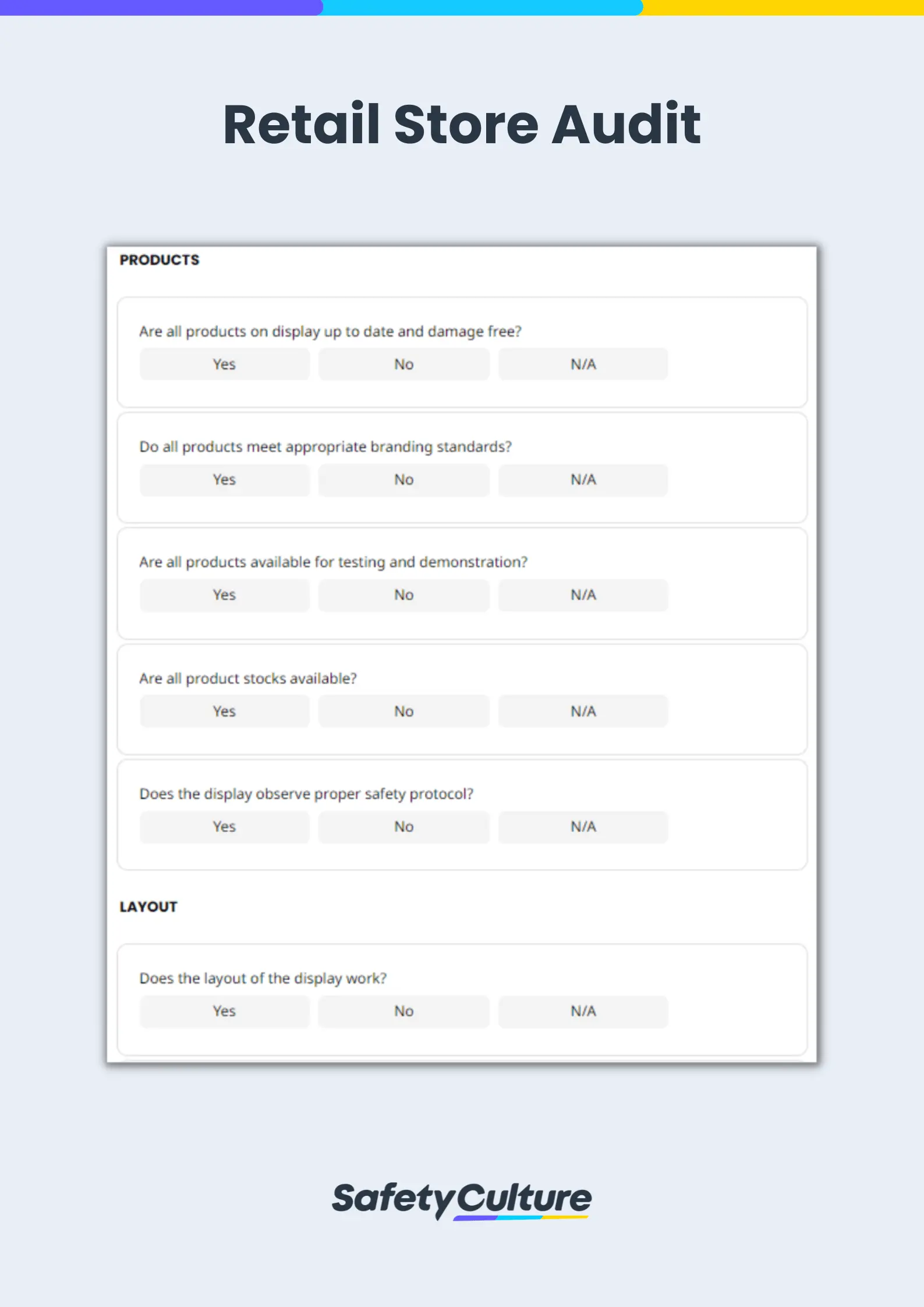What is a Retail Store Audit Checklist?
A retail store audit checklist is a useful tool that can effectively control and monitor retail outlets’ status, branding, processes, and standardization. Retail audit checklists are used by store managers or auditors to evaluate the effectiveness of store displays, keep track of product inventory, observe store employee performance and productivity, and ensure the cleanliness and safety of the store.
Why is Retail Audit Important?
A retail audit (or store audit) is a process of gathering information to assess and analyze store performance over time. Retail industries are advised to perform retail store audits to avoid the following:
- Selling of product that is beyond expiration dates which can cause your store hefty fines from regulators;
- Inappropriate marketing campaigns and strategy that can lead to lawsuits and public criticism;
- Non-compliance with safety requirements that can injure buyers and prompt government recalls;
- Inconsistent customer service that can damage your store reputation; and
- Unmanaged retail store performance that may lead to bankruptcy and store closure.
Retail Store Audit vs Visual Merchandising Audit
A retail audit usually encompasses general aspects of store operations such as inventory, productivity, safety, and merchandising. Meanwhile, a visual merchandising audit focuses on evaluating product location and displays, shelf space, and pricing and promotions.
How to Perform Retail Audits Effectively
Retail audits are essential tasks to monitor your retail store operations. They are usually performed to evaluate retail store products, identify improvement needs, and monitor advertising impact on your customers. To conduct retail store audits efficiently, you can follow these useful tips:
State the Objective of the Retail Audit
Retail businesses should be clear in identifying their goals. Retail audits should determine the things you would like to accomplish as well as the areas you would like to improve. Stating your business objective helps in analyzing the focus of your audit.
Standardize the Process
A scheduled audit helps ensure business compliance with regulatory standards. Allocate enough time to perform a retail audit without interrupting business operations or the customer experience. It is recommended to conduct regular store audits before opening and after closing the retail stores.
Thoroughly Inspect Facilities and Equipment
It is important to inspect electronic devices such as Point-of-Sale (POS) system, cash registers, printers, and phones before store operation starts. It helps ensure functionality and working condition of equipment to avoid any unnecessary delays and customer attrition.
Monitor Retail Display
Retail stores have to ensure all perishable products are within sell-by dates to prevent customer complaints and legal issues. They have to check, evaluate, and monitor display products if replacement or replenishment is needed to guarantee its availability to the customers.
Ensure a Safe and Secure environment
According to Gary Bonnett, QHSE Director from BOS Solutions “Everything has risk. It is our job as business professionals to control and minimize risks to an acceptable level. Uncontrolled risk can negatively affect businesses in many different ways. None of which lead to safe and happy work environments, productive and efficient process, and optimal profitability.”
With a retail compliance audit, you can ensure a safe and secure environment for not only your customers but also your employees. It helps avoid accidents, musculoskeletal injuries, health issues, and even fatalities.
Observe Employee Performance and Productivity
Retail audits should not only focus on the retail store and its environment but should also consider evaluating employees and their performances. Observe how they interact with customers and follow safety regulations and protocols. Evaluate how store managers perform their duties of handling staff to achieve the business goals.
Communicate Improvement Measures
Retail audit reports are necessary to allow business owners to analyze and assess store performances including net loss, profit, and Return of Investments (ROI). The analytics dashboard is helpful to easily identify the changes needed to maximize product sales.
Use a Retail Audit Checklist
Through compliance audit software, retail audit checklists can be made and used as an effective, step-by-step guide for performing store inspections. It helps in gathering comprehensive data to easily identify in-store working conditions, frequently failed items, and improvement needs, which can be abridged in a professional retail store visit report.
What to Include in a Retail Audit Checklist
A retail audit can help improve the quality of service of a branch or a retail store. A retail audit checklist is a tool used to assess the safe working conditions of the business that helps protect both employees and customers and usually covers the following:
Products
Assessing customer satisfaction is an important element of ensuring engagement with the product or services offered by the business. It is a way to organize and validate the effectiveness of the layout, promotional material, and product display of the retail stores.
Employees
Employees are important elements in achieving a common business goal. It is vital to ensure they have attended training on different processes, including product knowledge, emergency procedures, and security protocols. Observe if they are following personal hygiene practices and customer service etiquette.
Facilities
Maintaining the cleanliness of a retail facility can ensure workplace safety and establish an appealing facade to encourage customers to enter the store. It can help improve a healthy environment, employee productivity, and efficiency. Any potential hazards that can be overlooked can cause unforeseen incidents.
Retail Case Study
How SafetyCulture (formerly iAuditor) help Coles find the profound impact of using smartphones with their processes
“SafetyCulture empowers us to give the customers a shop that they can trust. It also gives us the ease and simplicity to let stores really get ahead of the game to deliver on opportunities to improve.” – Simon McBurney, Senior Delivery Analyst



